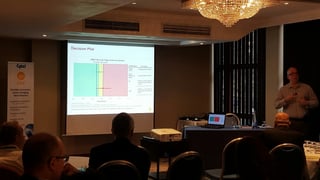Decision Making in Early Clinical Development

On March 16th and 17th the 5th East User Group Meeting took place in London. This very successful 2 days saw a variety of talks on aspects of clinical trial design innovation. Over the next couple of weeks, we will be reviewing some of the key topics which were addressed during the meeting.
In this post, we'll take a look at Paul Frewer of Astrazeneca's presentation on Decision Making in Early Phase Clinical Development. This talk was very well received by the delegates and prompted plenty of discussion afterwards.

Creating a Decision- Making Framework
Frewer presented engagingly about how Astrazeneca have developed and implemented an evidence based decision making framework within their early phase clinical development group. The approach (based on a methodology proposed by Lalonde, et al) was designed to enable the organisation to take forward the best compounds within a candidate rich, early phase portfolio. Frewer, et al's paper Decision Making in Early Clinical Drug Development on the topic is published in Pharmaceutical Statistics and available online.
The development of a consistent approach to quantitative decision-making means that studies are designed from the outset with the decision in mind. Importantly, once results are available they are interpreted against a pre-determined framework, allowing clear decisions to be made more quickly.
3 outcome framework
This is a 3 outcome decision framework which includes Go, Stop and Consider.
In order to implement the decision framework the following decision parameters are required:
- Target Value (TV) – or the desired level of performance
- Lower reference value (LRV) – the minimal level of performance
- False Stop Risk- Risk of a stop if the truth is better than TV
- False Go Risk -Risk of a go if the truth is worse than the LRV
The LRV and TV need to be scientifically justified, ideally from the Target Product Profile. Based on the input decision parameters, a standard decision plot is created to take to governance committees.
Where the outcome is in the Stop or Go zone, naturally the decision is clear. If the outcome is in the Consider zone, then decision criteria should also be developed on how to move out of this zone. For example, these criteria may be based on a secondary endpoint or using competitor data on a similar compound.
Future Implementation
While the framework has initially been developed in a Frequentist setting, the approach lends itself well to a Bayesian setting. Indeed, a custom software is now in final stages of development to take forward, and apply in both environments.
Importantly, Frewer noted that in early clinical development the approach was now "all about the decision" and not necessarily about P values. He highlighted the key role to be played by the statistician in this decision making process- ensuring that the TV and LRV are evidence based, generating the operating characteristics as well as consulting on improving the operating characteristics and use of interim analyses to investigate decision timings.
One of the advantages of Astrazeneca's approach which really resonated with the audience at the EUGM was that the framework provides a common basis for communication for the different stakeholders within a clinical study team.
Further Reading
Decision Making in Early Clinical Drug Development, Frewer, et al, Pharmaceutical Statistics, Article first published online: 17 March 2016
Model based Drug Development, Lalonde, et al, Clinical Pharmacology and Therapeutics 2007
2 talks on early phase go/no-go decision-making (Cytel Blog)

